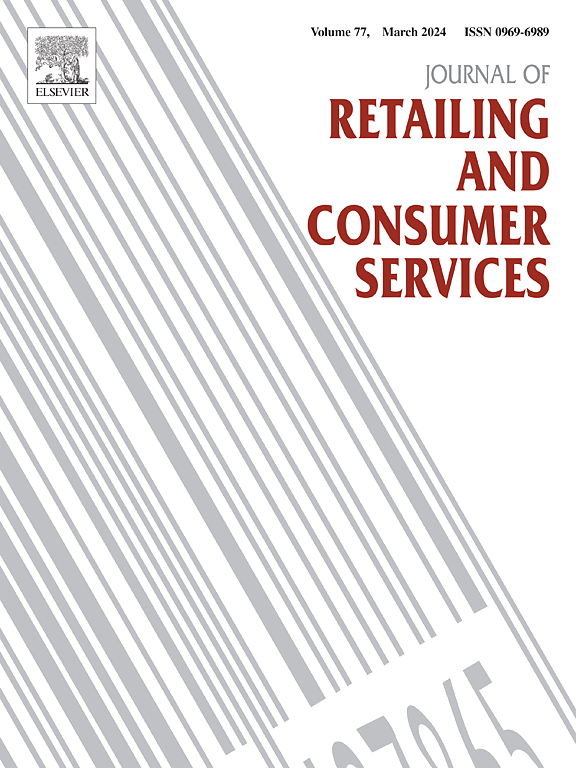直播电商的战略选择:平衡直播销售模式与退货运费保险策略
IF 11
1区 管理学
Q1 BUSINESS
Journal of Retailing and Consumer Services
Pub Date : 2025-06-02
DOI:10.1016/j.jretconser.2025.104347
引用次数: 0
摘要
直播商业正在迅速崛起。虽然与关键意见领袖(kol)合作通过产品信息共享提高了销售额,但价格限制和高额佣金侵蚀了电子零售商的利润。目前,由人工智能(AI)驱动的自流媒体通过降低产品不合适的风险,提供了具有成本效益的替代方案。然而,持续的不匹配问题仍然使电子零售商提供退货运费保险(RI)受到欢迎。我们探讨了电子零售商如何战略性地选择直播模式(顶级KOL、普通KOL或人工智能自流)和RI策略。使用两阶段博弈论模型,我们有以下主要发现。提供RI将提高零售价格,kol只有在降低产品不匹配风险的作用有限时才会增加佣金。与普通KOL相比,顶级KOL可能会利用议价能力来降低零售价格。此外,电子零售商最有可能在与常规KOL签约时提供RI(由于减少不匹配的限制),而与AI的自流合作最少。至关重要的是,提供RI可以补充顶级KOL协作,但不能替代它。研究结果进一步表明,如果单位产品打捞量低,或者单位打捞量高而顶级KOL具有高粉丝效应,则电子零售商可能更倾向于选择顶级KOL;否则,选择正规KOL是最优方案。特别是,如果采用人工智能的成本较低,kol的粉丝效应较弱,特别是在单位回收率较低的情况下,人工智能的自流就会蓬勃发展。这些结果可以帮助电子商务平台优化佣金,加强流媒体合作伙伴关系,并改进人工智能工具,以更好地匹配消费者产品。本文章由计算机程序翻译,如有差异,请以英文原文为准。
Strategic choices in live-streaming e-commerce: Balancing live-streaming selling mode and return-freight insurance strategy
Live-streaming commerce is swiftly rising. While collaborating with Key Opinion Leaders (KOLs) enhances sales through product information sharing, pricing constraints and high commission fees erode the e-tailer's margins. Currently, self-streaming powered by artificial intelligence (AI) offers cost-efficient alternatives by reducing product unfit risks. However, persistent mismatch concerns still make the e-tailer offer return-freight insurance (RI) popular. We explore how the e-tailer strategically selects live-streaming modes (top KOL, regular KOL, or self-streaming with AI) and RI strategies. Using a two-stage game-theoretic model, we have following key findings. Offering RI will increase the retail price, with KOLs increasing commission fees only when their role in reducing product misfit risks is limited. Compared to a regular KOL, the top KOL may leverage the bargaining power to drive down the retail price. Additionally, the e-tailer is most likely to offer RI when contracting with a regular KOL (due to limited misfit reduction) and least with self-streaming with AI. Crucially, offering RI can complement the top KOL collaboration but cannot substitute it. The findings further indicate that if unit product salvage is low, or unit salvage is high while the top KOL shows high fan effects, the e-tailer may prefer a top KOL; otherwise, choosing a regular KOL is the optimal solution. In particular, self-streaming with AI thrives if there are low AI adoption costs and weak KOLs' fan effects, especially when unit salvage is low. These results can help e-commerce platforms optimize commissions, enhance streaming partnerships, and improve AI tools for better consumer-product matching.
求助全文
通过发布文献求助,成功后即可免费获取论文全文。
去求助
来源期刊
CiteScore
20.40
自引率
14.40%
发文量
340
审稿时长
20 days
期刊介绍:
The Journal of Retailing and Consumer Services is a prominent publication that serves as a platform for international and interdisciplinary research and discussions in the constantly evolving fields of retailing and services studies. With a specific emphasis on consumer behavior and policy and managerial decisions, the journal aims to foster contributions from academics encompassing diverse disciplines. The primary areas covered by the journal are:
Retailing and the sale of goods
The provision of consumer services, including transportation, tourism, and leisure.

 求助内容:
求助内容: 应助结果提醒方式:
应助结果提醒方式:


